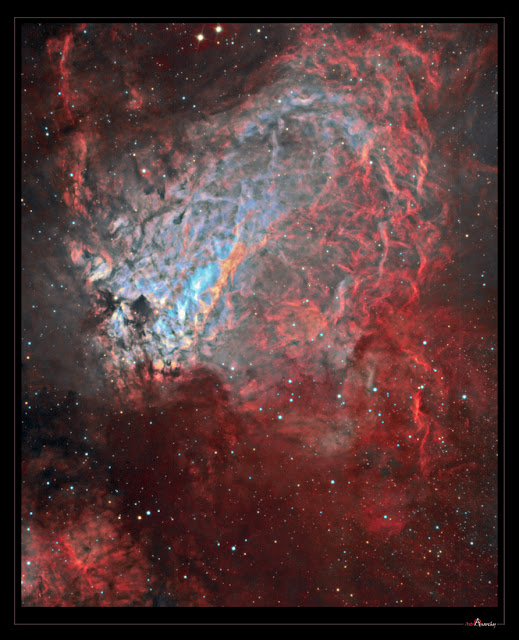Since my processing technique gets better and the time of year doesn't give any support, I have reprocessed some older images. There is now star colors added and other processing is tweaked too.
"Omega Nebula", M17, in Sagittarius
Ra 18h 20m 26s Dec -16° 10′ 36″
Image is in HST-palette from the emission of ionized elements, R=Sulfur, G=Hydrogen and B=Oxygen
M17, imaged with the Northern Galactic members remote telescope in Australia.
The Omega Nebula, also known as the Swan Nebula or the Horseshoe Nebula, cataloged as Messier 17 and NGC 6618. This H-II region loactes in constellation Sagittarius. Distance from Earth is between 5000-6000 light years and it spans about 15 light years in diameter. Image area is 30'x30', about half a degree.
Open cluster of 35 hot young stars lies inside of the nebula and causes ionization glow of the elements.
Natural color composition from the emission of ionized elements, R=80%Hydrogen+20%Sulfur, G=100%Oxygen and B=85%Oxygen+15%Hydrogen to compensate otherwise missing H-beta emission.
This composition is very close to a visual spectrum.
Original processing and details:
http://astroanarchy.blogspot.com/2010/06/m17-omega-nebula.html
My 3D-studies of the object:
http://astroanarchy.blogspot.com/2011/05/new-version-of-m17-stereo-pair-3d.html
The telescope and technical information:
16" RCOS ja Apogee U9000 camera.
LRGB combo.
H-alpha 6x1200s, Dark and Flat calibrated.
O-III 1x1200s, Dark calibrated
S-II 2x1200s, Dark calibrated
Raw data is shared with Petri Kehusmaa and J-P Metsavainio
Processing workflow:
Image acquisition, MaxiDL v4.xxx
Stacked and calibrated in CCDStack.
Deconvolution with a CCDSharp, 30 iterations
Levels, curves and color combine in PS CS3.
Seeing was not good at the time of imaging, FWHM 5"


0 comments:
Post a Comment